SGC SG-230 Operating Manual
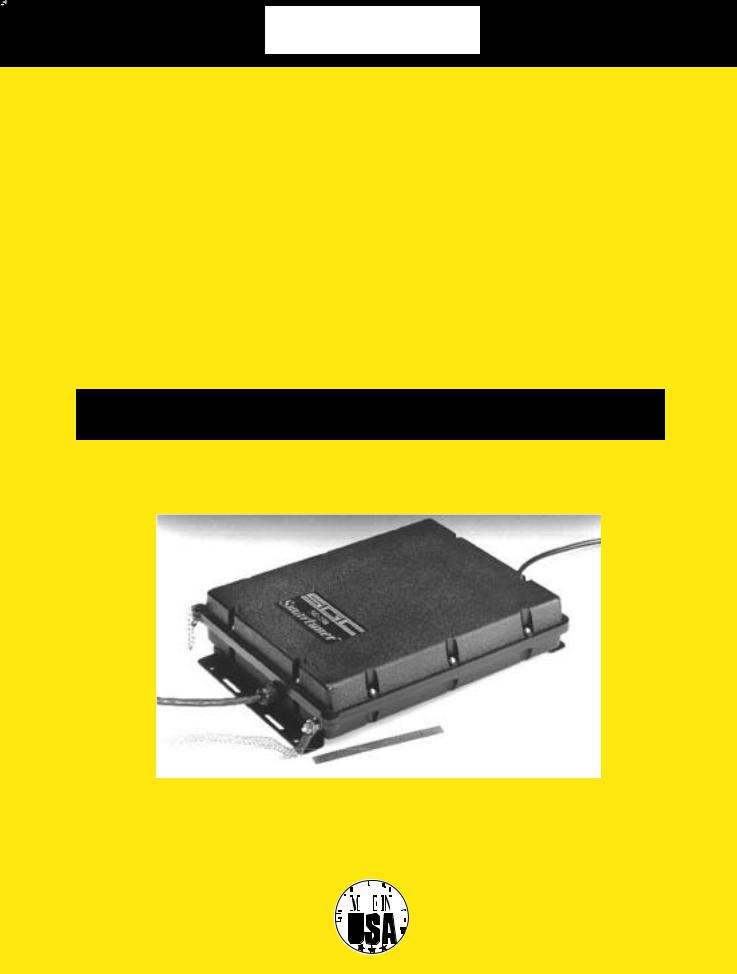
SG-230
Smartuner®
Microprocessor Controlled Automatic Antenna Coupler
Installation and Operations Manual
Getting the most from every watt of HF-SSB Power
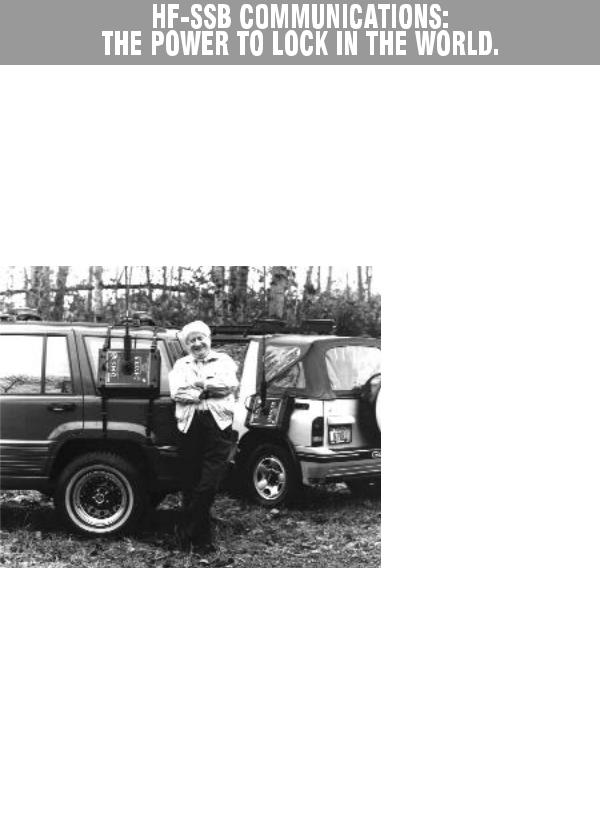
Globally, HF-SSB has literally changed the world. For a minimal investment, it has allowed millions of people - often in amazingly remote settings, often in emergency conditions - to reliably bounce clear voice and data signals across a state, across a continent, over an ocean, or around the world. Without satellites, relay stations, cellular nets, stadium sized antennas or huge user fees. Just some fine equipment, a smart operator and nature's own ionosphere make this possible.
For nearly 30 years, the perfection of HF SSB has been the focus and the life of our company. Our efforts have not gone unnoticed. Today, SGC is a prominent choice of leading corporations, governments, relief agencies, paramilitary organiza-
tions, mariners, aviators, explorers, and scientists - all over the world. They trust our engineering and they value our experience.
A vital part of our company's strategy centers around new product development, with an emphasis on providing quality equipment which remains rugged, reliable and competitively priced. We are focused on providing customer service of the highest standard. Our commitment is to product training and comprehensive after sales support. Today, SGC is recog-
nized as a world class designer and manufacturer of HF SSB communications products.
At SGC we build communications power tools. Next generation HF-SSB radios, antennas, amplifiers and coupler systems that squeeze more range and clarity out of every watt of HF SSB communications power, are the technology and innovations that have helped SGC emerge as a cutting edge player in the expanding world of HF-SSB.
Actually, SGC was the first company to perfect and mass produce solid-state HF SSB radios, almost 30 years ago. Today, our focus is an ever higher level of HF SSB refinement and performance. All focused on creating HF SSB voice and data communications systems that are so user friendly
and so powerful, they allow every SGC user to easily lock in the world.

 SMARTUNER MANUAL
SMARTUNER MANUAL
SG-230
SMARTUNER ANTENNA
COUPLER
Installation and Operations Manual
Revised: November 2000
Caution: Carefully read the “Quick Start” on the following page and all pertinent sections of this manual prior to operating your Smartuner for the first time. This unit will provide outstanding service if you follow the detailed recommendations within this manual.
SGC Inc. SGC Building, 13737 S.E. 26th St. Bellevue, WA. 98005 USA © Nov2000 SGC, Inc. P.O. Box 3526, 98009 Fax: 425 746-6384 Tel: 425 746-6310
E-Mail: sgc@sgcworld.com Web Site: www.sgcworld.com
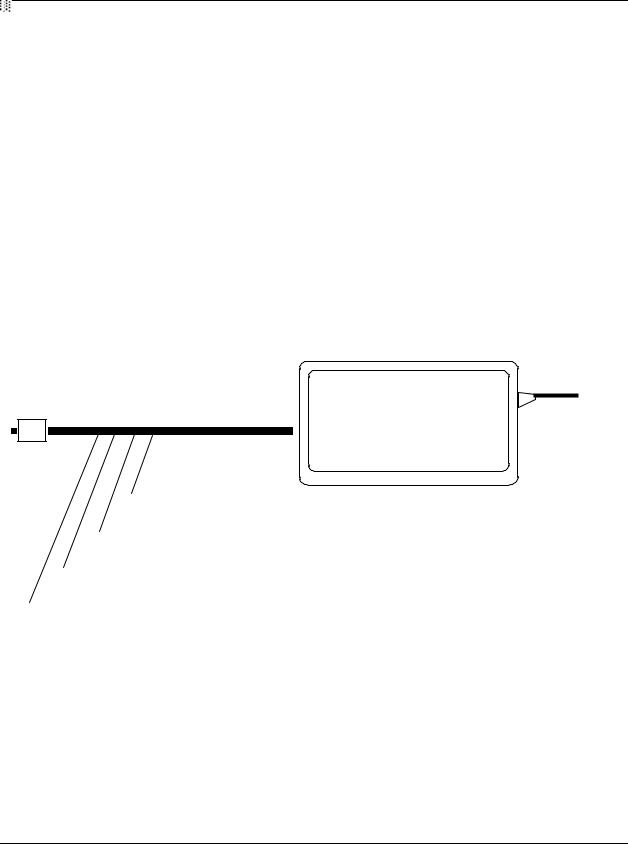
 SMARTUNER MANUAL ii
SMARTUNER MANUAL ii
Quick Start Guide
To quickly install your antenna coupler you will need the following:
1.An HF radio with 10 to 150 watts output.
2.An HF antenna with a single wire feed (not coax fed). Minimum length of 8 feet (to 3.5 MHz) or 23 feet (1.8 MHz).
3.A good ground or counterpoise for the antenna and coupler
4.+12 VDC and ground for the coupler.
5.An LED or other indicating device. (Optional)
Connections:
Connect the Smartuner as shown in the following diagram:
TO TRANSMITTER (10-200 w) |
Single wire |
|
|
|
ANTENNA |
|
Black: DC Ground |
|
|
|
|
|
|
|
|
|
|
|
|
|
|
GROUND (Counterpoise) |
|||
|
Red: +12 VDC coupler power |
|||
|
|
|
|
|
Red/ White: Optional SmartLock lock/ reset line. (+12 VDC locks, momentary ground resets)
Black/ White: Optional remote tuned indicator. Goes low when coupler is tuned
Operation:
1.Turn on Radio. Apply 12 VDC power to the coupler.
2.As power is applied, coupler should make one "click" sound.
3.Coupler should come up in the bypass (untuned) state.
4.To tune, speak normally, whistle or use CW.
5.Tuning should be done at full power. Clicking is heard.
6.When tuned, clicking stops and Black/White wire goes low.
|
SGC Inc. SGC Building, 13737 S.E. 26th St. Bellevue, WA. 98005 USA |
Nov2000 SGC, Inc. |
P.O. Box 3526, 98009 Fax: 425-746-6384 Tel: 425-746-6310 |
|
E-Mail: sgc@sgcworld.com Web Site: www.sgcworld.com |

 SMARTUNER MANUAL iii
SMARTUNER MANUAL iii
|
Table of Contents |
|
Quick Start Guide ....................................................................................................... |
ii |
|
1.0 General Information............................................................................................. |
1 |
|
1.1 |
Experience Levels of Users ....................................................................... |
1 |
1.2 What Is an Antenna Coupler? .................................................................. |
1 |
|
1.3 |
Overall Description.................................................................................... |
3 |
1.4 Coupler Network Configuration ............................................................. |
4 |
|
1.5 |
Operation Indicators.................................................................................. |
4 |
1.6 |
Mechanical Design ..................................................................................... |
5 |
|
1.6.1 Marine Mounting ........................................................................ |
6 |
|
1.6.2 Desert and High Temperature Installations............................ |
7 |
|
1.6.3 Extremely Cold Temperature Installations ............................. |
7 |
1.7 |
Remote Installations................................................................................... |
7 |
1.8 Upgrade Sequence...................................................................................... |
8 |
|
2.0 Specifications ......................................................................................................... |
8 |
|
2.1 |
Accessories .................................................................................................. |
9 |
2.2 Recommended Antennas .......................................................................... |
9 |
|
3.0 Parts and Technical Support ............................................................................... |
9 |
|
3.1 |
Parts Furnished........................................................................................... |
9 |
3.2 |
User Supplied Items................................................................................... |
10 |
3.3 |
Technical Support....................................................................................... |
11 |
4.0 Antenna Types....................................................................................................... |
11 |
|
4.1 |
Antenna Selection....................................................................................... |
11 |
4.3 Longwire Antenna ..................................................................................... |
12 |
|
4.4 |
Backstay Antennas ..................................................................................... |
12 |
4.5 |
Typical Installations................................................................................... |
12 |
|
4.5.1 Jeep installation ........................................................................... |
12 |
|
SGC Inc. SGC Building, 13737 S.E. 26th St. Bellevue, WA. 98005 USA |
Nov2000 SGC, Inc. |
P.O. Box 3526, 98009 Fax: 425-746-6384 Tel: 425-746-6310 |
|
E-Mail: sgc@sgcworld.com Web Site: www.sgcworld.com |

 SMARTUNER MANUAL iv
SMARTUNER MANUAL iv
|
4.5.2 Vehicle installation...................................................................... |
13 |
|
4.5.3 Motor Vessel installation............................................................ |
14 |
|
4.5.4 Base installation........................................................................... |
14 |
|
4.5.5 Base installation with ground wire radials.............................. |
15 |
|
4.5.6 Base dipole.................................................................................... |
16 |
|
4.5.7 Base Quadra Loop....................................................................... |
16 |
|
4.5.8 Delta Loop .................................................................................... |
17 |
|
4.5.9 Vessel Groundless Loop............................................................. |
18 |
|
4.5.10 Vessel insulated backstay......................................................... |
19 |
4.6 Apartment Loop Antenna......................................................................... |
19 |
|
4.7 |
Recreational Vehicle (RV) Antennas ....................................................... |
20 |
4.8 |
Aircraft Antennas....................................................................................... |
21 |
4.9 |
Low Profile, Hidden................................................................................... |
22 |
4.10 Emergency Antennas............................................................................... |
24 |
|
|
4.10.1 Kite Antenna .............................................................................. |
24 |
|
4.10.2 Tactical Installations.................................................................. |
25 |
4.11 Five Golden Rules of HF Installation………………………………….26 |
||
5.0 General Notes on Antennas ................................................................................ |
27 |
|
5.1 |
Steps to Antenna Installation.................................................................... |
28 |
5.2 |
Antenna Location ....................................................................................... |
28 |
5.3 Ground Systems—General ....................................................................... |
29 |
|
|
5.3.1 Vehicle Grounds .......................................................................... |
29 |
|
5.3.2 Marine Grounds .......................................................................... |
30 |
|
5.3.3 Base Station Grounds.................................................................. |
31 |
5.4 |
Corrosion ..................................................................................................... |
32 |
5.5 Antenna Coupler Mounting ..................................................................... |
32 |
|
5.6 Antenna Connection .................................................................................. |
32 |
|
|
SGC Inc. SGC Building, 13737 S.E. 26th St. Bellevue, WA. 98005 USA |
Nov2000 SGC, Inc. |
P.O. Box 3526, 98009 Fax: 425-746-6384 Tel: 425-746-6310 |
|
E-Mail: sgc@sgcworld.com Web Site: www.sgcworld.com |

 SMARTUNER MANUAL v
SMARTUNER MANUAL v
6.0 Installation Procedures......................................................................................... |
33 |
|
6.1 |
Installation with SG-2000 .......................................................................... |
33 |
6.2 |
Installation on all Radios........................................................................... |
33 |
6.3 |
Smartlock Installation................................................................................ |
34 |
6.4 Weatherdeck Mounting............................................................................. |
35 |
|
6.5 |
Electrical Checkout..................................................................................... |
35 |
6.6 Do-It-Yourself Light-Bulb Dummy Load……………………………….36 |
||
7.0 Coupler Configuration......................................................................................... |
38 |
|
7.1 Schematic Diagrams................................................................................... |
38 |
|
7.2 |
Tuning Process............................................................................................ |
39 |
7.3 |
Impedance Detector ................................................................................... |
39 |
7.4 VSWR Detector ........................................................................................... |
39 |
|
7.5 |
Phase Detector ............................................................................................ |
40 |
7.6 |
Central Processing Unit (CPU)................................................................. |
40 |
7.7 |
Initialization ................................................................................................ |
40 |
8.0 Tuning Processes and Options ........................................................................... |
41 |
|
8.1 |
Program Description.................................................................................. |
42 |
8.2 |
Tuning Paths ............................................................................................... |
43 |
9.0 Smartlock Operation............................................................................................. |
46 |
|
9.1 Tune, Tune Lock, and Reset...................................................................... |
46 |
|
9.2 |
Smartlock Notes.......................................................................................... |
46 |
10.0 |
Receiving |
Antenna |
Systems…………………………………………………...47 |
|
|
11.0 Troubleshooting the SMARTUNER................................................................ |
47 |
|
11.1 Ground Faults ........................................................................................... |
48 |
|
11.2 Antenna Faults.......................................................................................... |
49 |
|
11.3 Transmitter Faults .................................................................................... |
50 |
|
11.4 A Final Pointer on Troubleshooting ...................................................... |
50 |
|
|
SGC Inc. SGC Building, 13737 S.E. 26th St. Bellevue, WA. 98005 USA |
Nov2000 SGC, Inc. |
P.O. Box 3526, 98009 Fax: 425-746-6384 Tel: 425-746-6310 |
|
E-Mail: sgc@sgcworld.com Web Site: www.sgcworld.com |

 SMARTUNER MANUAL vi
SMARTUNER MANUAL vi
12.0 Further Reading…………………………………………………………………51
SUBJECT INDEX......................................................................................................... |
52 |
|
SGC Inc. SGC Building, 13737 S.E. 26th St. Bellevue, WA. 98005 USA |
Nov2000 SGC, Inc. |
P.O. Box 3526, 98009 Fax: 425-746-6384 Tel: 425-746-6310 |
|
E-Mail: sgc@sgcworld.com Web Site: www.sgcworld.com |

 SMARTUNER MANUAL 1
SMARTUNER MANUAL 1
1.0 General Information
The Smartuner™ reputation has grown to legend status because it is simple to use and a highly reliable piece of electronic equipment. A SMARTUNER will provide maximum transfer of radio energy from any HF transmitter to any end-fed HF antenna within the frequency and power limits of its specifications. The SMARTUNER builds upon the renowned reputation of the SG-230 by adding many advanced features, among them: a new, highly technological microcontroller that has built in A/D functions, non-volatile memory, and serial communications capabilities.
This document is designed to guide the SMARTUNER user through installation and operation of the unit. This document will also recommend various steps that may be undertaken in the field to provide correct operation of the SMARTUNER should difficulty be encountered. Smartuners are extraordinarily reliable. But you should be aware that there are scores of fine points to any HF installation that are easily overlooked and may cause difficulty. Our goal in this manual is to help you quickly obtain the best possible performance from your HF radio installation. By reading this manual carefully, you can avoid most of the pitfalls that can degrade the performance of your HF system.
1.1 Experience Levels of Users
The Smartuner may be installed successfully by anyone with the help of this manual. However, if you are inexperienced in HF radio installation and operation, do not be shy about seeking advice from people with more experience than yourself. They will help you achieve good results quickly and with minimum frustration. Even the most experienced professional HF users will occasionally run into difficulty.
Regardless of the level of your experience, SGC stands ready to offer you installation suggestions and help you resolve any aspect of Smartuner operation that is not entirely satisfactory. If you have a specific question, please send us an email or fax at our Bellevue, WA headquarters on the bottom of this page. If you require telephone assistance, please call us between 8:00 A.M. to 5:00 P.M. Pacific Time.
1.2 What Is an Antenna Coupler
Antenna “couplers” are placed at the antenna and precisely match conditions of the antenna to the feed line. Antenna “tuners,” on the other hand, are generally located at the transmitter output at the radio end of the coaxial feed line. Do not be confused by the term “coupler” or “tuner.”
•A tuner placed at the transmitter fools a transmitter into working correctly.
•A coupler installed at the antenna eliminates feed line losses by providing a
© Nov2000 SGC, Inc. |
SGC Inc. SGC Building, 13737 S.E. 26th St. Bellevue, WA. 98005 USA |
P.O. Box 3526, 98009 Fax: 425-746-6384 Tel: 425 746-6310 |
|
|
E-Mail: sgc@sgcworld.com Web Site: www.sgcworld.com |

 SMARTUNER MANUAL 2
SMARTUNER MANUAL 2
proper match of the antenna to the feed line. The Smartuner is a true antenna coupler.
The several key points, which we will emphasize throughout this manual, will result in the best possible operation of your Smartuner. These include:
•The coupler must be located at the antenna.
•No coax may be connected to the coupler output.
•The coupler must have clean +12 VDC power supplied to it.
•The ground system must always be larger than the antenna.
•The antenna wire should be of the largest gauge practical.
•Capacitance at the coupler output must be minimal.
•The antenna should be of sufficient length for your lowest operating frequency.
Strictly observing these basic rules will insure good operations under the widest range of conditions.
This manual should be thoroughly studied if you plan to have the best possible signal and most reliable operation of your HF system.
Please make note of the following information for your records:
Date unit was purchased:
Dealer from whom purchased:
Date installed:
Type of antenna used:
© Nov2000 SGC, Inc. |
SGC Inc. SGC Building, 13737 S.E. 26th St. Bellevue, WA. 98005 USA |
P.O. Box 3526, 98009 Fax: 425-746-6384 Tel: 425 746-6310 |
|
|
E-Mail: sgc@sgcworld.com Web Site: www.sgcworld.com |
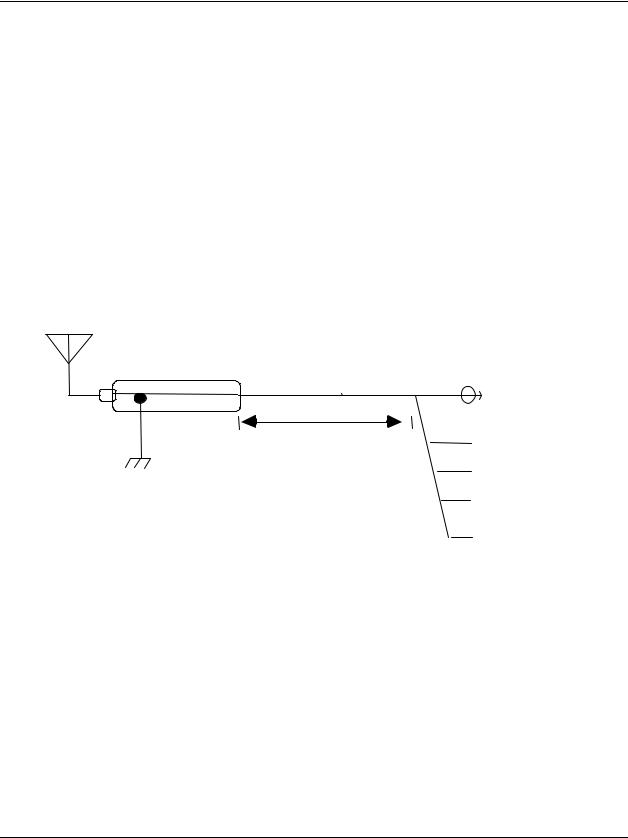
 SMARTUNER MANUAL 3
SMARTUNER MANUAL 3
1.3 Overall Description
The SMARTUNER is a general-purpose coupler that can operate with any type of radio and almost any type of antenna configuration. The coupler network con-figuration is of a pi or L type; sensors continually monitor the state of the tuning and relay this information to the processor.
The initial (first time) tuning may take several milliseconds to a few seconds de-pending on the complexity of the tuning process for a specific antenna configuration. After tuning the first time for a specific frequency and antenna, this information is entered in the non-volatile computer memory that will store up to 170 tuning solutions.
When the same conditions are encountered again, re-tuning is accomplished within 20 milliseconds by recalling the information from the non-volatile memory. Special software has been designed by SGC to allow accurate and fine-tuning of the coupler. For software description, refer to the MicroTune™ section of the manual.
|
SG-230 SMARTUNER |
|
|
(side view) |
To Transmitter |
|
|
|
|
|
PL-259 |
Wire antenna |
|
9 feet (2.8 mtr) |
Large Ground or counterpoise system |
Blk - Ground |
|
|
|
Red +12 VDC |
|
Red/ Wht - SmartLock |
DIAGRAM OF SMARTUNER INSTALLATION |
control line |
|
|
|
Blk/ Wht - Remote |
|
Tuned Indicator |
If antenna or transmitter conditions have changed since the information was stored in memory, the coupler retunes and a new tuning solution is achieved. This new information is stored to memory for future reference. The Smartuner will always look for the best possible tuning solution and will improve existing tuning solutions whenever possible.
The SMARTUNER may be bypassed and your antenna used as a broadband receiving antenna. To do this, turn off the power to the coupler for two seconds and then turn it back on, or simply press the reset button on the SmartLock. In this situation, the coupler is reset to stand-by waiting for the first RF power to be transmitted before providing a tuning solution. In the stand-by mode, the antenna bypasses tuning elements and connects the antenna directly to the receiver with no tuning elements engaged. This allows for receiving signals throughout the HF range.
© Nov2000 SGC, Inc. |
SGC Inc. SGC Building, 13737 S.E. 26th St. Bellevue, WA. 98005 USA |
P.O. Box 3526, 98009 Fax: 425-746-6384 Tel: 425 746-6310 |
|
|
E-Mail: sgc@sgcworld.com Web Site: www.sgcworld.com |

 SMARTUNER MANUAL 4
SMARTUNER MANUAL 4
The coupler will cease to operate normally if input voltage drops below 10.5v DC. This situation may occur if a marginal battery is used or if you are transmitting at high power with an inadequate power supply or battery. Batteries must be fully charged for proper operation. Large gauge wiring to the transmitter and coupler must be used to avoid retuning.
If broadband operation is required during scanning operations, jumper JP-1 on the printed circuit board inside the coupler may be set to the “YES” mode. This will bypass tuning elements on receive. Jumper JP-1 is located near U1.
In some cases, it may be desirable to re-tune the coupler and bypass the memory information. If you wish to bypass the recalled tuning solutions, place jumper JP-2, also located near U1, to the “NO” position.
1.4 Coupler Network Configuration
The coupler network configuration is designed with 64 different input capacitor values, 32 output capacitor values, and 256 inductor values, thus providing about a half million different pi or L configurations. The coupler requires an input of 3 to 200 watts to operate. The unit operates on +12 VDC and can be optionally supplied to operate at +24 VDC. The +24 VDC option may be installed in the field. Please contact your dealer or SGC and order Part Number 54-52.
1.5 OPERATION INDICATORS
Operational status of the coupler and the onboard computer’s tuning decisions is displayed by five LEDs, which are located on the main printed circuit board (PCB). These indicators are only visible when the cover of the coupler is removed. These five LEDs are not designed to be interpreted by other than factory and trained service personnel.
CAUTION: Dangerous high voltages exist inside the Smartuner when it is operated with an HF transmitter. High RF voltages in excess of 10kv may be expected in normal operation of this unit. In addition to shock hazard, these RF voltages may produce burns that are very painful if you come in contact with exposed components. Therefore, DO NOT operate without the cover secured in place unless you are a well experienced radio technician or engineer.
As a matter of good installation and engineering practice, exposed metal antenna elements should be located in such a manner as to prevent accidental contact with people (especially young children), pets, and small animals.
© Nov2000 SGC, Inc. |
SGC Inc. SGC Building, 13737 S.E. 26th St. Bellevue, WA. 98005 USA |
P.O. Box 3526, 98009 Fax: 425-746-6384 Tel: 425 746-6310 |
|
|
E-Mail: sgc@sgcworld.com Web Site: www.sgcworld.com |
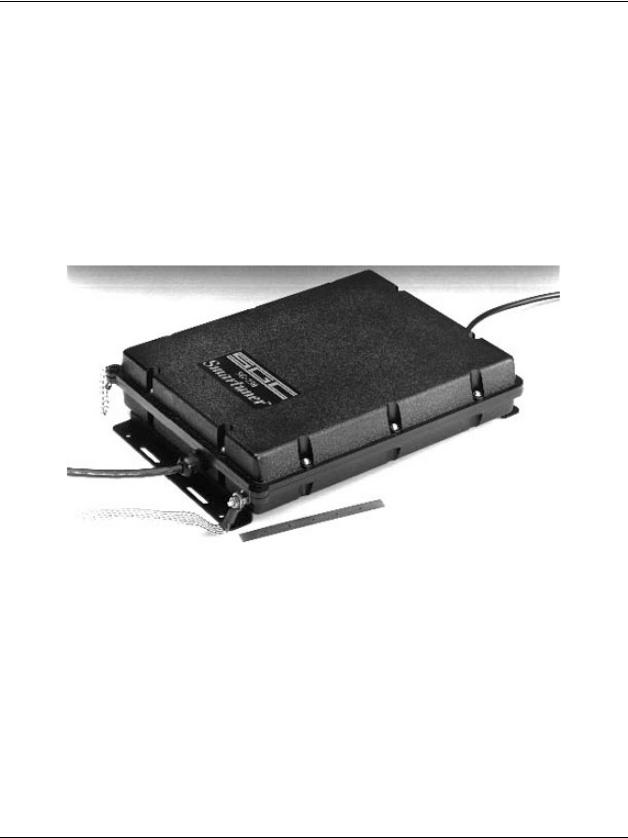
 SMARTUNER MANUAL 5
SMARTUNER MANUAL 5
1.6 Mechanical Design
The SMARTUNER is supplied in a weatherproof case with two mounting brackets. RF and DC power are supplied to the unit through the same cable. This special cable consists of a 50-ohm coaxial cable and four conductors. The four conductor wires are for the ground, the positive power lead, the optional SmartLock control, and optional LED indicator.
The SMARTUNER antenna coupler’s weatherproof case is designed to withstand the environmental conditions encountered aboard ship when mounted on the weatherdecks. The internal construction is designed to withstand the shock and vibration of marine service. Corrosion-resistant hardware and passive alloys are employed throughout.
We do not recommend opening the SMARTUNER case unless it is necessary. For 99% of installations, the factory settings for jumpers will be correct. Should you have occasion to open the case, use care to ensure the gasket that seals the unit is relocated properly to maintain watertight integrity of the unit.
Although the SMARTUNER is built very solidly, it is good installation practice to provide additional protection from the elements. SGC makes the following recommendations:
© Nov2000 SGC, Inc. |
SGC Inc. SGC Building, 13737 S.E. 26th St. Bellevue, WA. 98005 USA |
P.O. Box 3526, 98009 Fax: 425-746-6384 Tel: 425 746-6310 |
|
|
E-Mail: sgc@sgcworld.com Web Site: www.sgcworld.com |

 SMARTUNER MANUAL 6
SMARTUNER MANUAL 6
1.6.1 Marine Mounting
The SMARTUNER should be located inside the house or under the aft lazaret on a sailboat. On powerboats, the coupler may be mounted outside, but an addition protective housing is recommended. The preferred installation if vertical is with the standoff insulator pointing upward.
A stuffing gland for the RF and DC cables is provided on the lower edge of the weather housing, along with a 1/4-20 stainless steel ground stud. The antenna connects to the ceramic insulator on the top of the weather housing.
The SMARTUNER may be mounted in any position including inverted without any degradation of performance. If the coupler is to be exposed to long periods of high vibration, such as aboard helicopters or tug boats, installation of the optional shock mounting is recommended.
1.6.2 Desert and High Temperature Installations
The SMARTUNER may be used in very hot climates on a continuous basis if some additional protection from direct sunlight is provided. The best protection for a mobile installation is provided by the QMS (Quick Mounting System) that keeps the antenna coupler outside of a vehicle. Temperatures inside a vehicle may exceed 212°F (100°C). If a QMS is not used, it is desirable to keep the coupler in the shade if possible. Please refer to the diagram in the following section.
1.6.3 Extremely Cold Temperature Installations
Your SMARTUNER will operate down to specified temperatures. We recommend placing the SMARTUNER under some kind of housing other than the case to prevent heavy build up of ice. If you are mounting on a tower in a hot or cold climate, a plastic wastebasket (such as those made by Rubbermaid™) makes an excellent weather cover and costs only a few dollars.
© Nov2000 SGC, Inc. |
SGC Inc. SGC Building, 13737 S.E. 26th St. Bellevue, WA. 98005 USA |
P.O. Box 3526, 98009 Fax: 425-746-6384 Tel: 425 746-6310 |
|
|
E-Mail: sgc@sgcworld.com Web Site: www.sgcworld.com |
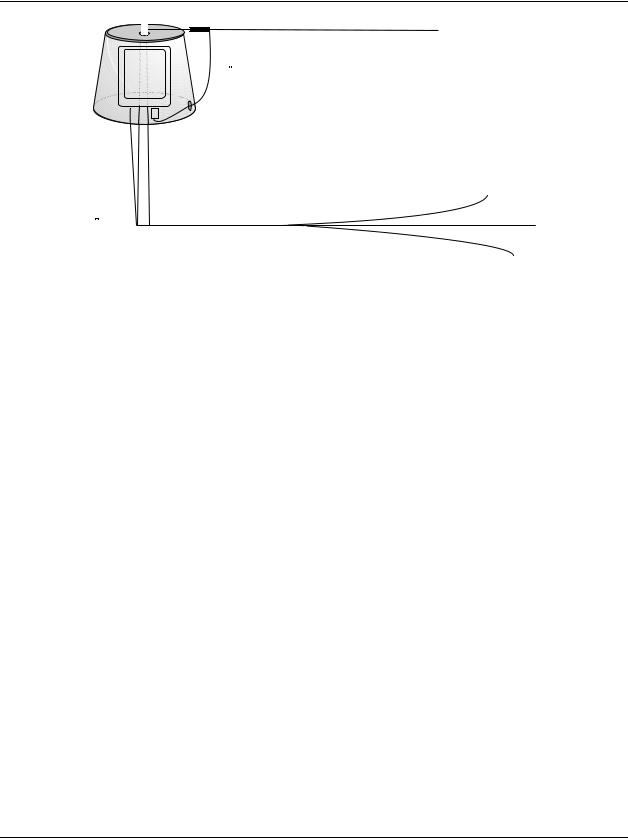
 SMARTUNER MANUAL 7
SMARTUNER MANUAL 7
Long wire antenna
Smartuner mounted inside a plastic waste basket to protect it from extreme heat and heavy icing. This type of enclosure is widely available in all countries.
1.6.4 Warranty Note
It is important to have protection from the elements as common weather conditions can reach beyond the capabilities of the coupler. Although the SG-230 coupler is fully waterproof and was created to withstand normal weather conditions, warranty will be voided if left exposed directly to extreme weather such as snow, rain, and ice or prolonged sun exposure. Even in milder climates, direct and constant sunlight can exceed the safe operating temperature and can shorten the lifespan of your coupler.
1.7 Remote Installations
The SMARTUNER is supplied with 9 feet of cable standard. SGC has two standard lengths of antenna extension cable available in the event you need to mount the cable farther than 9 feet from the transmitter. A 25-foot extension cable is available (SGC Part Number 54-65) as is a 50-foot cable (SGC Part Number 54-66).
If you need to install the antenna coupler more than 50 feet from the transmitter site, up to two extension cables may be used for a total of 75 or 100 feet. However, SGC does not recommend installing the Smartuner more than 100 feet from the transmitter because two losses must be considered.
• The first loss in long distance installations is normal attenuation of the radio signal coming from the antenna to the radio via the coax. As you may be aware, the longer the coaxial cable run, the higher the loss will be. The amount of loss is dependent on frequency. At 2 MHz, the loss is approximately .5 dB, while at 30 MHz the loss in 100 feet of coaxial cable is over 2 dB. This means that a 100-watt transmitter would actually deliver about 70 watts to the antenna after running through 100 feet of coax at 30 MHz.
If you are seeking the utmost performance at 30 MHz and you cannot avoid a run of 100 feet, or longer, we recommend using a larger low loss type of coax such as RG-8
© Nov2000 SGC, Inc. |
SGC Inc. SGC Building, 13737 S.E. 26th St. Bellevue, WA. 98005 USA |
P.O. Box 3526, 98009 Fax: 425-746-6384 Tel: 425 746-6310 |
|
|
E-Mail: sgc@sgcworld.com Web Site: www.sgcworld.com |

 SMARTUNER MANUAL 8
SMARTUNER MANUAL 8
(foam dielectric) or Belden type 9943 coax. Both of these will reduce attenuation to less than 1 dB per hundred feet. You should be aware that this heavier cable is less easy to work and may be quite expensive.
• The second loss which must be considered is the losses in the DC power and reset control line. At any distance other than the 9-foot cable that is supplied by SGC, we recommend that the DC voltage at the antenna coupler be measured because if the coupler voltage drops below 10 volts, the coupler may not operate properly.
For this reason, SGC recommends that if distances are great, the input DC voltage at the transmitter site be adjusted to provide for +12 to +14 volts at the coupler site.
We do specifically advise against use of a different power supply than the one used to power the radio because of the danger of creating ground loops which may cause oscillation of the final amplifiers or other undesired side effects. If you decide to use a separate power supply mounted at the antenna coupler location, please be advised that SGC does not provide technical support in this area.
1.8 Upgrade Sequence
The current version of the SMARTUNER coupler will have a revision letter located on the printed circuit board. To continue moving forward in coupler design, the SMARTUNER may be revised as needed. Later revisions of the coupler will be denoted by the subsequent letters of the alphabet.
SGC will continue making incremental improvements in the SMARTUNER product. When you buy your product today and a new feature is added, you can always upgrade for modest fees to the latest version of the unit. If you would like to upgrade to the latest version of the unit, contact SGC because special discounts are always provided to our valued customers.
2.0 SPECIFICATIONS - SMARTUNER
HF Frequency Range: |
1.8 to 30.0 MHz |
|
Note: The SMARTUNER may be operated as low as |
|
1.6 MHz and is commonly used as an antenna- |
|
matching unit for differential GPS transmitter site |
|
antennas. However, when operated under these |
|
conditions, a longer antenna is recommended, such |
|
as a 60-foot tower section for operation in the 1700- |
|
1710 kHz band and an appropriately larger |
|
counterpoise. In addition, inductor heating may |
|
become pronounced at high power levels in the |
|
SMARTUNER's inductors, which are commonly |
|
used at these frequencies. For this reason, we |
© Nov2000 SGC, Inc. |
SGC Inc. SGC Building, 13737 S.E. 26th St. Bellevue, WA. 98005 USA |
P.O. Box 3526, 98009 Fax: 425-746-6384 Tel: 425 746-6310 |
|
|
E-Mail: sgc@sgcworld.com Web Site: www.sgcworld.com |

 SMARTUNER MANUAL 9
SMARTUNER MANUAL 9
|
|
|
recommend 70 watts at 1700 kHz and 50 watts at |
|
|
|
|
1600 kHz on a continuous basis. |
|
|
Power Input Range: |
3 to 200 watts (PEP) |
||
|
Input Impedance Range: |
45 to 55 ohms |
||
|
VSWR: |
(Typical) |
Typically less than 1.4:1 |
|
|
DC Input Requirement: |
+13.8 VDC |
||
|
DC Operating Range |
+10.5 to 15 VDC |
||
|
Input Current: Average: |
.9 amps |
|
|
|
Random set time: |
Typical: less than 2 seconds |
||
|
Recurrent set time: |
Typical: less than 10 milliseconds |
||
|
Non volatile memory address: |
170 |
|
|
|
Antenna Length: |
Minimum length of 8 ft. —3.5 to 30 MHz |
||
|
|
|
Minimum length of 23 ft. —1.8 to 30 MHz |
|
|
Installation: |
Any position |
||
|
Operating Temperature: |
-35° to +70°C |
||
|
Size: |
|
16 x 12 x 3 inches |
|
|
Weight: |
|
8 pounds (3.5 kilos) |
|
|
Case Construction: |
Plastic ABS weatherproof case |
||
|
Control Cable: |
SGC special cable, 9 feet coaxial and two power |
||
|
|
|
Input wires (plus remote tune LED wire replaceable |
|
|
|
|
by any standard cable) |
|
|
2.1 Accessories |
|
|
|
|
|
|
Shock Mounting Tray. SGC Part Number 54-50 |
|
|
|
|
+24 VDC Power option. SGC Part Number 54-52 |
|
|
|
|
25-foot extension cable. SGC Part Number 54-61 |
|
|
|
|
50-foot extension cable. SGC Part number 55-62 |
|
|
2.2 Recommended Antennas |
|
||
|
|
|
SG-105 |
Marine and Base station antenna. This is a |
|
|
|
60 foot end fed long wire type antenna. SGC Part |
|
|
|
|
Number 55-10. |
|
|
|
|
SG-107 Delta Loop Antenna. This is a delta loop 11 |
|
|
|
|
meters high by 11 meters wide at the base. SGC Part |
|
|
|
|
Number 55-12. |
|
|
|
|
SG-203 Marine 28 foot whip antenna. This antenna |
|
|
|
|
is used for most powerboat installations. SGC Part |
|
|
|
|
Number 55-24. |
|
|
|
|
SG-303 High performance 9-foot whip antenna. |
|
|
|
|
This dual element antenna is designed for severe |
|
|
|
|
||
© Nov2000 SGC, Inc. |
SGC Inc. SGC Building, 13737 S.E. 26th St. Bellevue, WA. 98005 USA |
|||
P.O. Box 3526, 98009 |
Fax: 425-746-6384 |
Tel: 425 746-6310 |
||
|
|
E-Mail: sgc@sgcworld.com Web Site: www.sgcworld.com |
||

 SMARTUNER MANUAL 10
SMARTUNER MANUAL 10
marine and land mobile service. SGC Part Number 55-27.
QMS - Quick Mounting System that houses SMARTUNER Smartuner and also provides a sturdy mounting platform for the SG-303 antenna system. Designed for fly away installations requiring no holes installation of high performance HF antenna system. SGC Part Number 55-45.
3.0 Parts and Technical Support
SGC supplies SMARTUNER equipment; the user supplies suitable radio and antenna.
3.1Parts Furnished
1.Antenna Coupler
2.9 foot special cable (RG-58 plus 4 conductors in a single jacket.)
3.Instruction Manual
3.2User Supplied Items
The user of the SMARTUNER will need to supply a suitable HF radio antenna. Such an antenna may be as simple as an 8-foot-long piece of wire and several ground/ counterpoise radials of 8 feet or longer. The longer the antenna, up to about 80 feet, the better all around performance will be. Longer antennas may be used, but please refer to the sections on antennas for discussion of limitations.
The user will also have to supply a good counterpoise. Such a counterpoise is a large metal surface (much larger electrically than the antenna). Generally, the bigger the counterpoise, the better your signal will be.
3.3 Technical Support
Before contacting SGC for technical support, please take a few minutes to think through your installation and ask if there is anything obvious that you have overlooked in the installation. Check to make sure your ground system is both adequate and tight and that proper voltage is supplied to the coupler.
In the event you experience difficulty with your SMARTUNER antenna coupler, you should contact SGC for technical advise. Before calling, we ask you to have the following information ready so that we may readily assist you.
© Nov2000 SGC, Inc. |
SGC Inc. SGC Building, 13737 S.E. 26th St. Bellevue, WA. 98005 USA |
P.O. Box 3526, 98009 Fax: 425-746-6384 Tel: 425 746-6310 |
|
|
E-Mail: sgc@sgcworld.com Web Site: www.sgcworld.com |

 SMARTUNER MANUAL 11
SMARTUNER MANUAL 11
Coupler Information. Please have the serial number of your coupler, the name of the dealer from whom the unit was purchased, and the approximate date of purchase.
Antenna Information. Please be ready to describe your antenna installation. You will need to advise us whether the antenna is a wire type, a dipole, V, vertical, long wire, or whip antenna.
Ground System. You should be ready to describe your ground system in detail. If you are dealing with a marine installation, you should have a description of the vessel's bonding system. If you are using the coupler in a mobile setting, you should be able to describe bonding of the hood, trunk, and other vehicle parts that may have been done. In an aircraft, you should be able to describe location of the coupler and type of ground connection used.
Power supply voltage. One of the common mistakes made when installing couplers is to assume that a connection is good when it hasn't been measured. If you experience any type of erratic or intermittent operation, please measure the power supply voltage inside the coupler.
. Describe Coupler behavior. If you are having a problem, determine if it is happening all the time or only part of the time. Does the problem occur only on certain frequencies? Does the problem happen only in certain modes?
. Be patient. Finding the reason for less than ideal system operation may take one telephone call or it may take several calls. Regardless of how complex the problem is, your SGC representative will be able to walk you through the process of solving your problem in a logical step-by-step manner. The Smartuner
and accessories will always give top performance when carefully installed.4.0
Antenna Types
The automatic antenna coupler is designed for use with end-fed unbalanced antennas such as whips and long wires. The radiating portion of the antenna is connected directly to the coupler through a high voltage insulator. It is extremely important that the antenna type, site location, and grounding technique be correctly chosen so that the system will radiate effectively.
Wideband antennas (e.g., log periodic) that cover the full range of the system may be used with the coupler if desired. Narrow band resonant antennas, such as dipoles, Vs, and inverted Vs may only be used if the antenna VSWR (including coaxial feeder) is less than, or equal to 3:1 at the operating frequency.
Note that if a dipole or V type antenna is used, the antenna may be operated at any frequency within the range of the coupler if each side of the V or dipole is 23 feet or
© Nov2000 SGC, Inc. |
SGC Inc. SGC Building, 13737 S.E. 26th St. Bellevue, WA. 98005 USA |
P.O. Box 3526, 98009 Fax: 425-746-6384 Tel: 425 746-6310 |
|
|
E-Mail: sgc@sgcworld.com Web Site: www.sgcworld.com |

 SMARTUNER MANUAL 12
SMARTUNER MANUAL 12
longer. In addition, the SMARTUNER is just as happy feeding a conventional V antenna as an inverted V. The coupler is flexible in this regard.
4.1 Antenna Selection
The automatic antenna coupler will operate into almost any end-fed antenna with a length of 2.5 meters or more, provided an effective ground is used. The antenna efficiency will generally be proportional to length and in most applications will be maximum at a length of 1/4 wavelength. This means that the longest possible antenna should be selected for each installation.
Very short antennas are only recommended when there is no other alternative such as in a vehicular mobile installation. The performance of short whip antennas is usually very poor, particularly at the lower frequencies, and radiation efficiency will be only a few percent of a full sized antenna. However, a special electrically long antenna such as the SG-303 9-foot antenna overcomes the radiation problem.
4.2 Whip Antennas
2.5 to 3.0 Meters (8 to 9 feet)
This antenna is recommended only for vehicular mobile installations. The short length will result in poorer performance compared with the longer antennas. A special high performance 9-foot antenna, the SG-303, is manufactured by SGC specifically for this problem. (SGC Part Number 55-27.)
7.0 to 8.5 Meters (28 feet)
This antenna is recommended for marine installation on smaller vessels. It may also be used in base stations if there is no way of using a longer antenna. The SG-203 is this type of antenna. (SGC Part Number 55-23.)
10.7 Meters (35 feet)
This is the preferred antenna for marine installation when there is no room for a longwire antenna. It will also provide reasonable efficiency for base station use and is the shortest recommended base antenna. (SGC Part Number 55-24 for the SG-204 35 foot whip antenna.)
4.3 Longwire Antenna—23 Meters (75 feet); 46 Meters (150 feet)
For most applications, the longwire antenna will give the best results and is recommended when practical. The diagrams at the end of this section show some recommended methods of installation. These are only a few of the many possible methods of installation, and frequently a different configuration will be the best at a
© Nov2000 SGC, Inc. |
SGC Inc. SGC Building, 13737 S.E. 26th St. Bellevue, WA. 98005 USA |
P.O. Box 3526, 98009 Fax: 425-746-6384 Tel: 425 746-6310 |
|
|
E-Mail: sgc@sgcworld.com Web Site: www.sgcworld.com |
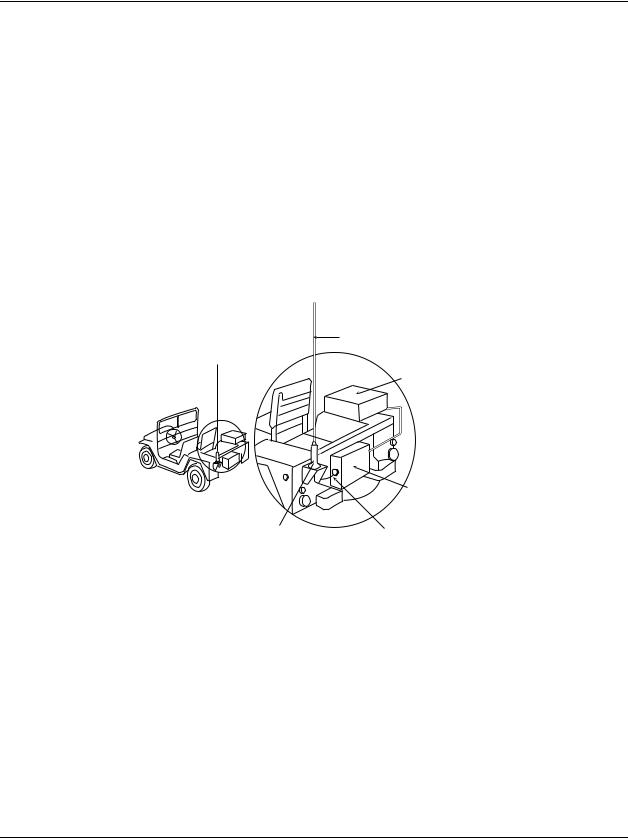
 SMARTUNER MANUAL 13
SMARTUNER MANUAL 13
particular site. SGC’s long wire antenna, 60 feet in length, provides efficient operation on low frequencies and high frequencies alike. (SGC Part Number 55-10.)
4.4 Backstay Antennas —8 Meters (28 feet) and Longer
Although we would love to sell everyone a high performance marine whip antenna, the backstay of a sailboat is almost impossible to improve upon in most installations.
4.5 Typical Installations
Figures 4.5.1 through 4.5.11 show some typical installations for the automatic antenna coupler.
Figure 4.5.1 Jeep installation
Jeep Installation |
3.0 M whip |
|
|
||
for Automatic |
Detail |
|
Antenna Coupler |
||
Transceiver |
||
|
|
Coupler |
|
Feed-through |
GTO cable |
|
(as short as possible) |
||
insulator |
||
|
Figure 4.5.2 Vehicle installation
© Nov2000 SGC, Inc. |
SGC Inc. SGC Building, 13737 S.E. 26th St. Bellevue, WA. 98005 USA |
P.O. Box 3526, 98009 Fax: 425-746-6384 Tel: 425 746-6310 |
|
|
E-Mail: sgc@sgcworld.com Web Site: www.sgcworld.com |

|
SMARTUNER MANUAL 14 |
Ground |
3.0 M whip |
|
|
coupler |
|
securely |
Feed through insulator |
to truck |
|
Coupler |
|
Transceiver |
|
Vehicle Installation
Figure 4.5.3 Motor Vessel installation
Feed through insulator
Coupler
Suitable stay cable
Ground to steel bulkhead or overhead
Motor Vessel Installation
© Nov2000 SGC, Inc. |
SGC Inc. SGC Building, 13737 S.E. 26th St. Bellevue, WA. 98005 USA |
P.O. Box 3526, 98009 Fax: 425-746-6384 Tel: 425 746-6310 |
|
|
E-Mail: sgc@sgcworld.com Web Site: www.sgcworld.com |

 SMARTUNER MANUAL 15
SMARTUNER MANUAL 15
Figure 4.5.4 Base installation
COUPLER
Figure 4.5.5 Base ladder installation
© Nov2000 SGC, Inc. |
SGC Inc. SGC Building, 13737 S.E. 26th St. Bellevue, WA. 98005 USA |
P.O. Box 3526, 98009 Fax: 425-746-6384 Tel: 425 746-6310 |
|
|
E-Mail: sgc@sgcworld.com Web Site: www.sgcworld.com |

 SMARTUNER MANUAL 16
SMARTUNER MANUAL 16
up to 300 feet
up to 40 feet
Balanced Line Feeders
300-600 Ohms 
 GND
GND 


 Hot
Hot
Coupler
RF cable DC Control cable
Base Ladder Installation
Figure 4.5.6 Base installation with ground wire radials
|
|
Insulator |
|
11M |
2M |
|
|
|
Insulator |
30° |
|
|
|
|
GTO cable |
|
30° |
Coupler |
|
|
|
|
2M
Radial wires  Ground cable No. 4 AWG buried in soil
Ground cable No. 4 AWG buried in soil
(150 cm maximum)
Base Installation with
 Conduit for Ground Wire Radials control cable
Conduit for Ground Wire Radials control cable
and coax
Figure 4.5.7 Base dipole installation
© Nov2000 SGC, Inc. |
SGC Inc. SGC Building, 13737 S.E. 26th St. Bellevue, WA. 98005 USA |
P.O. Box 3526, 98009 Fax: 425-746-6384 Tel: 425 746-6310 |
|
|
E-Mail: sgc@sgcworld.com Web Site: www.sgcworld.com |

 SMARTUNER MANUAL 17
SMARTUNER MANUAL 17
1 m e t e r |
|
3 meters |
|
|
E 6 6 i n s u l a t o r s |
Hot |
( x 8 ) |
|
|
G N D |
7 to 25 meters |
Coupler
 3 meters
3 meters
DC Supply Line
RF Cable
Base Dipole Installation
Figure 4.5.8 Base Quadra Loop Horizontal
Radiation
Porcelain isolators with tie rope
Coupler
Ground bolt
terminal
Antenna 50 ohm terminal coax from
transmitter
Base Quadra
Loop Horizontal
The horizontal quad loop is a groundless antenna for high angle radiation and is ideal for HF communications up to 500 miles in the frequency range of 2 to 10 MHz. This configuration provides optimum near-right angle reflection to the ionosphere for shortrange communications.
A square base can be from 8 to 15 meters long and can be configured to the shape of the structure as necessary, to provide the best arrangement. The height of the supporting poles should be 20 to 40 feet. Supporting poles should be as tall as possible to provide the antenna with the greatest isolation from industrial noise generated by the building, such as fluorescent lights and electrical motors. Loop antennas are also less susceptible to industrial RF noise generated by the building, because they are isolated from the ground system of the building.
Loop wires are attached at one end on the high voltage active side of the coupler and on the other end at the ground side of the coupler.
Figure 4.5.9 Base Delta Loop
© Nov2000 SGC, Inc. |
SGC Inc. SGC Building, 13737 S.E. 26th St. Bellevue, WA. 98005 USA |
P.O. Box 3526, 98009 Fax: 425-746-6384 Tel: 425 746-6310 |
|
|
E-Mail: sgc@sgcworld.com Web Site: www.sgcworld.com |
